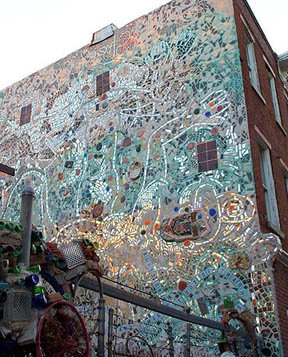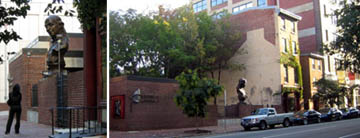Over at artblog, writer Andrea Kirsh took the opportunity to dump on Philly’s public art as an introduction to her review of two new books about public art in New York City. As Public Art Network gathers in Philly next June, here is my response to her.
Ms. Kirsh. Your assessment of the public art in Philly fails to grasp Public Art in its cultural and artistic role. Your critique is fine for readers in the artculture. From that perspective, you might be generally correct. But the artculture is generally limited in its abilities to assess public art as it is lazy. Local cultural investigation is just too much work, so remain with artculture values. I too in my blog at Artsjournal.com fail to sufficiently investigate.
As to Philly, first you need to provide links to www.philart.net with Chris Purdom’s massive documentation of public art in Philly. And the mural database developed at UPenn is outstanding at cml.upenn.edu/murals.
Second: Many artworks in Philly dramatically outclass anything in NYC for their visual impact and cultural relationships. The scale of the giant murals of American African figures in distressed neighborhoods may be some of the most powerful public art works in the world. I know they stopped me in my tracks.
Tim Spencer by Cliff Hudson and Dr. J by Kent Twitchell
Herman Wrice by David McShane & Eurhi Jones and Malcolm X by James Burns & Ernel Martinez
The mosaic work of Isaiah Zagar covering thousands of square feet of buildings south of downtown Philly entertained me for an hour – a long time to appreciate public art. Lily Yeh’s Village in Germantown with its memorials and murals should have international stature for its integration of community building and artistic excellence.

Isaiah Zagar. Photo by Mosaic Art Source
Lily Yeh’s Village of Arts and Humanities
Philly’s fifteen or more Ben Franklin public artworks is pleasantly insane. James Peniston installed the lastest in October, 2007. The Rocky sculpture at the museum strikes hard at the relationship between art, popular movies and picture taking – an important cultural relationship.
I continue to strive for intellectual and artistic excellence in public art, but with additional critical values added to important ones of artculture

James Peniston’s Keys To Community
Digg it…Del.icio.us …Technorati…Stumble Upon..Reddit

From Tom Borrup
Thank you for your observations and comments. I spent three days in Philly a few years ago taking in the same set of public artworks that you wrote about and I agree that they exhibit great power and meaning in their context. How wonderful that so many artists have taken to the streets and taken on their environment in this way!
Lou Joseph writes
I think you’re forgetting that there is no such thing as good public art. This is true.
Also, I could also watch any random movie for an hour, it doesn’t mean it’s good or valid, just that I am easily entertained.
Weiss responds.
In a variety of evaluations, good public art exists and distraction by mediocre entertainment is not my criteria.
it would be great if one could click on the pictures and see a bigger version. In the same way that it is difficult to judge the power of a great painting from a postcard sized reproduction, public art, like great painting should be seen and evaluated in the flesh.